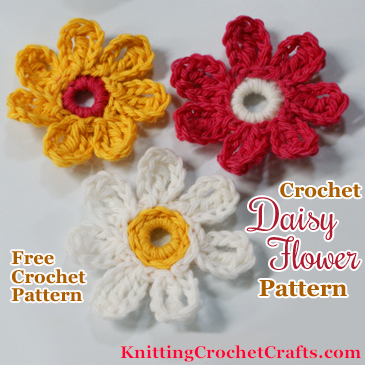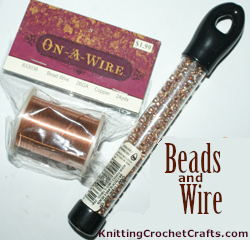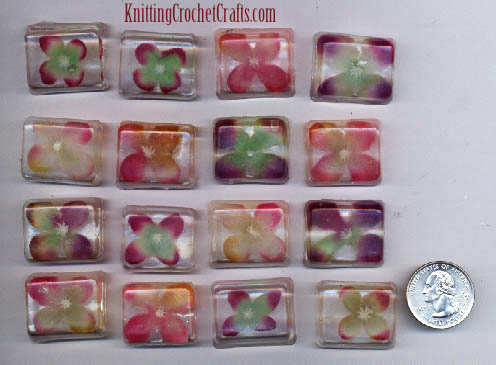Free Materials Plus Purchased Materials You Can Use for Making a Collage
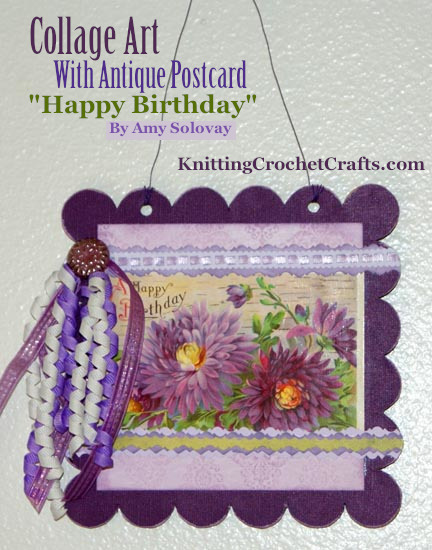
Collage Art With Antique Postcard Plus Other Objects Including a Czech Glass Button, Ribbons, Wire, and Chipboard.
There are many beautiful things about collage. One of them is that you can make a collage almost completely out of free materials. I say “almost completely” because you do usually have to pay for some sort of adhesive. Otherwise, it’s easy to find free and recycled things to use in your collages.
At first, I was going to make this a list of free things you can use in your collages, but then I decided to expand the list and make it a more comprehensive list of ideas for things you could use — free or not. In many cases, I had a hard time deciding whether it would be acceptable to list a particular item as being available for “free”.
For example, “buttons” and “fabric” are both items on this list; neither buttons or fabric are free, but if you have a shirt that ripped and you can’t wear it any more, you can harvest the buttons and the fabric and cut them up to use in your collages. So there are instances where you could use some buttons and fabric without incurring any additional expense at the time, although the materials technically are not free.
“Hardware” is another item on the list; it isn’t free, or even cheap. On the other hand, over the years I’ve picked up dozens of small metal washers and nuts off the ground that I’ve used in my collages — for free, of course. You can’t count on finding free hardware on the ground, but when you do come across it, you can certainly incorporate it into collages — or you could even pay for hardware sometimes when you feel that a particular project warrants spending money on it.
Items to Collage With
1. Beads — Small seed beads are interesting inclusions in a collage. It could also be interesting to include other types of beaded embellishments or doodads in a collage, but use caution in selecting the materials you use together; when using heavy embellishments, you need to take care to choose both a base and adhesive that can support the weight. I’m personally a bit hesitant to use large / heavy beads in my collages, due to the weight and the challenges involved with attaching them — but please don’t let my reluctance stop you if you have good ideas for how to address these challenges.
The collage pictured here shows one more possibility for incorporating beads, in the form of a beaded trim along the lower edge. (update — Sorry, I think I accidentally lost the picture of that collage in the great hard drive failure of 2007. I have it backed up…somewhere…and I’m hoping to post it again if I can find it).
This collage also features a few more instances of the free-but-not-always-free craft supplies I already mentioned. Both the beaded fringe and the ribbon were items that I got for free because I volunteered in a theatre costume shop, and a few small bits of these trims were left over after we finished making the costumes that the trims were intended to embellish.
To paint these papers, I used dyes that were leftovers from an unrelated tie-dyeing session. Even the papers were scraps that were left over from another project.
Overall, this collage was created at very little cost, and I’m quite proud of the fact that it utilized so many scrap materials and materials that might have ended up in the landfill otherwise.
2. Buttons Buttons are a great way to add interesting colors and shapes to your collage art. You can find buttons that celebrate a vast array of different themes and occasions; they also come in a wide range of colors and fabrications.
3. Cabochons — These are usually used in jewelry-making, but why not include them in your collages too? Cabochons have flat backs, which makes them easier to work with than, say, rocks and stones. Cabochons can be made of many different materials — plastic, polymer clay, stone, glass, etc. Be sure to start with a strong backing material, and to choose an appropriate adhesive when collaging with heavy cabochons.
4. Canvas — Canvas is a trendy material right now for all sorts of crafting techniques, and it’s especially well-suited for collaging with. You can paint on it, alter it, dye it, glue things to it and achieve all sorts of interesting effects with it.
5. Chipboard — There are zillions of different things you can do with chipboard, and bunches of different ways to incorporate it into a collage. Scrapbookers have tons of different chipboard embellishments available, and you can use those in your collages if you wish. If you need numbers, symbols or alphabet letters, you can usually find chipboard stickers that will work. Some die-cutting machines will cut chipboard, so if you have a die-cutter, you can make your own interesting shapes and embellishments out of chipboard. You can also cut some qualities of chipboard using good old-fashioned cutting tools like scissors.
6. Crochet Flowers — If you know how to crochet, or you’re willing to learn how, you could make lovely flowers that would be an eye-catching addition to your collage.
7. Doilies — Paper doilies, lace doilies and crocheted doilies all make lovely additions to collage art.
8. Dried Flowers, Leaves and Foliage — The garden is a fantastic source of free or low-cost materials for collage. All it takes is a bit of time to dry the flowers. There are artists who use dried flowers as their exclusive media for creating lovely collages. That’s one possibility; it’s also possible to incorporate dried flowers into collages that utilize other media as well.
9. Embroidery Floss — You can stitch right on your collage using embroidery floss; or alternatively, you can glue it on or attach it in other ways. Collage art is a great way to use up bits and pieces of floss that are too short to stitch with.
I often use several short lengths of braided embroidery floss to make hangers for my collages or art pieces.
10. Envelopes — There are lots of different possibilities for adding envelopes to your collage art. You could hide a secret message inside an envelope and attach it to your collage, or you could cut up the envelope and use the paper for various purposes. I often work with small gift-tag sized envelopes, but you could also use larger greeting-card sized envelopes or even manila envelopes. I also LOVE collaging with the envelopes that bills come in. I find it endlessly interesting to cut shapes out of the blue and white patterns on the insides, using craft punches or my scissors. I also enjoy cutting out and using the clear address windows in interesting ways.
11. Faux Flowers — If you want to use faux flowers in your collages, I suggest shopping for them in the scrapbooking aisle at your local craft store, rather than the floral aisle. The flowers that scrapbookers use are designed to be adhered to paper, so it saves you steps — not to mention lots of wasted materials– when you use the faux flowers for scrapbookers.
As an alternative, you could make your own faux flowers using a flower loom.
12. Fabric — Fabric scraps are fun to use in collage; you can cut them into shapes or sew them into little embellishments like yo-yos or flowers.
13. Felt — Felt embellishments have been popular with paper crafters lately, and it’s easy to see why. Felt is versatile, and allows you to achieve lots of interesting effects. You can stitch on it, sew beads onto it, glue things on it, make pockets out of it, and of course, add it to your collage or other craft project.
14. Rhinestones and Faux Gems — If you’re looking for an easy way to add sparkle to your collages, the rhinestones and gems that scrapbookers use are an easy choice; they are also widely available and easily affordable.
15. Broken Jewelry — A broken piece of jewelry = lots of creative potential for use in collages and assemblages. Just be careful of the weight; the heavier the piece, the heavier the backing needed to support it, and the stronger the adhesive needs to be.
16. Acrylic Shapes — There are a wide variety of acrylic shapes and pieces available for crafting with — letters, frames, hearts, circles, and many others.
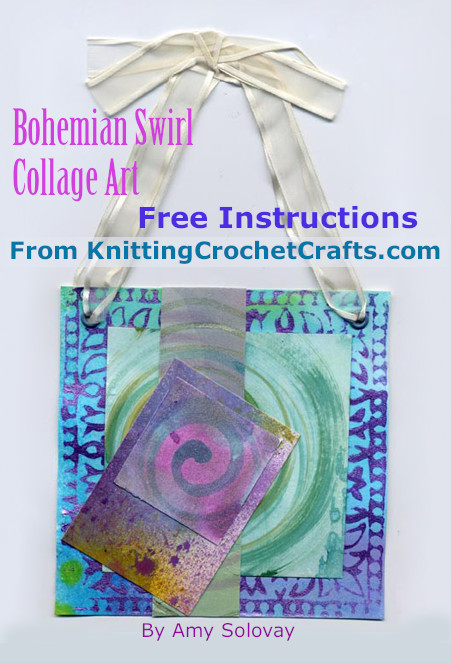
Here you can see a collage art piece that incorporates items other than just paper. This particular piece also makes use of scrapbooking eyelets and ribbon.
17. Eyelets — I often use eyelets in my collages, and there are many reasons you might want to use them, too. If I want to add a ribbon hanger to my collage, I’ve found that eyelets are a neat, easy and sturdy way to make the holes in the collage that I thread my ribbon through. In general, eyelets are an eye-catching way to incorporate holes into your collages, and this method is usually sturdier than just punching or poking a hole in the collage. Keep in mind that, if you use eyelets, you’ll also need some sort of eyelet setting tool as well.
18. Fringe — I often use interesting fringes and trims along one edge of my collages (usually the lower edge, but sometimes the upper edge.) I like using beaded fringe, but it can get heavy, and it also makes the piece fragile and more difficult to transport. Still, there’s nothing quite like it; it can add a fancy finishing touch to make a collage extra-special.
19. Game Pieces — For years, it was trendy to use scrabble letters and similar game pieces in collage art. This trend has faded, and in my opinion you might not want to emulate it unless you want your collage to look like it’s from that era (circa late 90s through mid 2000s.) Of course, there are plenty of other game pieces you could use, and plenty of interesting ways to use them, without your work looking dated.
20. Gift Tags — After your Christmas or birthday gifts are unwrapped, collect any pretty gift tags left over and add them to your stash of collage materials.
21. Glitter — Glitter can add sparkle and visual interest to any collage.
22. Greeting Cards — Collage is a fantastic way to give new life to old greeting cards you’ve received. You can cut out parts, or use paper punches to punch out parts like the sentiments, or words, or pictures.
23. Hardware — Small metal bits like washers and nuts and chain can make interesting additions to collage art. Be careful of the weight, because these tend to be really heavy. Sometimes you can find hardware that’s meant for scrapbooking, and those pieces might be lighter weight and better-suited to paper crafts than the pieces you’d typically find at the hardware store.
24. Labels — Any sorts of labels are fair game for collaging with. If you have a Dymo label machine, you could use it to make compelling statements to add to your collages; other types of label stickers could be equally intriguing to use.
25. Lace — Lace could dress up and prettify any collage.
26. Magazine Pages — If you have some old magazines hanging around, you can cut out letters, pictures and bits of pictures to include in your collage art. This is a particularly fun activity for kids to work on.
27. Mica Powder — Mica powder is a lot like glitter, but I think it’s even prettier. It’s a substance people use for making cars, nail polish and cosmetics shiny; it tends to be more sophisticated and less obnoxious than your average craft glitter. Look for Pearl Ex, which is a popular brand name of mica powder marketed for crafters.
28. Pages From Damaged Books — Vintage and antique books are a fantastic source of imagery to use in collage.
29. Paper — Just about any paper could become part of your next collage — cardstock paper, colored paper, plain paper, notebook paper, ledger paper, graph paper, old paper, new paper, patterned paper, tissue paper, index cards, handmade paper, ETC!
30. Pipe Cleaners — You can twist pipe cleaners into interesting shapes, and make all kinds of fun pictures or illustrations with them. It would be interesting to make an entire collage using pipe cleaners, or to incorporate them into a collage that also includes other materials.
31. Pom-Poms — You can buy ready-made pompoms, or you could make them yourself out of yarn. Either way, they could be an interesting addition to your collage.
32. Photographs – Photo collages are some of the most popular types of collage-making projects.
33. Postcards — These are great addition to travel-themed collages and picture collages.
34. Ribbon — There are so many interesting ways to incorporate ribbon into your collage art. Ribbon could make a nice border for one edge of your collage, or several edges. You can tie ribbon into bows and attach it to the collage, or use it for weaving in and out of holes in a collage.
35. Rubber-Stamped Images — You can rubber stamp an image, color it in (if desired,) cut it out, and use it in a collage. Or you could also rubber stamp directly onto your collage, if you prefer.
36. Sand — There are artists who use colored sand as their primary media for creating collages. It’s also possible to use sand in combination with other collage materials.
37. Seed Packages — Seed packages usually feature interesting color photographs on the front. Vintage and antique seed packages are popular with collage artists, for two reasons. One, the imagery is lovely, and two, you can sometimes find seed packages where the copyright protection on the illustration has expired, and the illustration is now in the public domain. This is important for collage artists who wish to sell or reproduce their work.
38. Sequins — Add a little sparkle and pizzazz to your collage with sequins.
39. Stickers — Stickers are an easy way to incorporate an image or sentiment into your collage. There are stickers available for just about every conceivable theme or occasion. I tend to use bunches of alphabet stickers and letter stickers in my collages.
40. String — You could tie all kinds of interesting things onto your collages using string or twine.
41. Trash — This might sound gross, but really, the trash can and the recycle bin are two of the best-ever places for locating collage materials. People throw away all kinds of interesting things that could be collaged. Cereal boxes and candy wrappers could both be cut up and used for collage. Colored plastic bags could provide endless collage material.
42. Victorian-Era Calling Cards — Way back when, small printed calling cards, similar to business cards, were popular items. If you happen to have any of these beautiful bits of history in your possession, they make lovely additions to collage art.
43. Wire — Wire is available in a wide variety of colors, materials and gauges. You can twist wire into all kinds of interesting configurations and shapes to use in your collage work. Additionally, you can crochet or knit with it and incorporate the crocheted or knitted bits into your collage as well.
44. Wood Pieces — For best results, you’d probably want to use small, thin pieces of wood, like popsicle sticks or “Woodsies.”
45. Wrapping Paper — After any gift-giving occasion has passed, gather up any used-but-useable giftwrap that can be salvaged, and add it to your stash of collage materials.
46. Yarn — If there are people in your collage, you could use yarn for creating their hair. You could also tie it into bows, weave it in and out of holes in the collage, or do some stitching with the yarn on the collage. This is a great way to use up scrap yarn left over from your crochet, knitting or weaving projects.
47. Molded Resin Tiles or Pieces
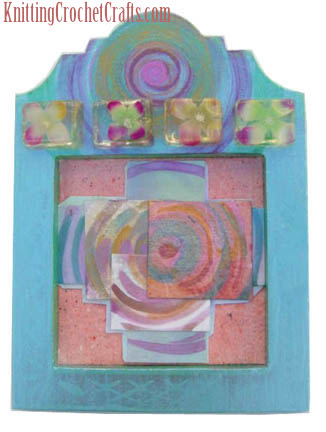
Resin Crafts: Collage Art Featuring Handmade Paper, Spin Art, and Cubes of Resin With Tiny Silk Flowers Embedded Inside Them
Resin is a unique medium you can use for collage art or a broad variety of other art and craft techniques. Resin is moldable and sculptable; if you pour it into molds, you can embed small objects like beads and buttons inside it. Then it hardens into solid plastic-y pieces like the ones you see pictured here. It’s pretty amazing stuff. Learn more about it in our guide to resin crafts.
Adhesives to Use for Collage:
48. Mod Podge — Mod Podge is a fantastic adhesive to use for paper collages and other paper crafts. It’s main advantage: you can use it to glue all your papers down, and also for adding an interesting finish to your collage. The type of finish depends on the specific bottle of Mod Podge that you buy, for example, if you buy the Glossy Mod Podge, your collage will have a glossy finish wherever you apply it.
49. Zip Dry Paper Glue — Don’t let the name fool you; Zip Dry Paper Glue is more than just a glue for paper, although it is the best paper glue I know of. Zip Dry also works well on other surfaces including plastic, acrylic, chipboard, and other surfaces. I wouldn’t recommend it for use on glass, but otherwise it’s an all-around great adhesive to use for collage.
50. Guterman Fabric Glue — If you’re going to glue fabric, trim, lace, yarn or felt onto your collage, you need an adhesive that won’t soak into your fabric and discolor it.
51. Wood Glue — If you’re making a collage that involves gluing wood to wood, you’ll need a good wood glue to get the job done.
Choosing a Collage Base:
It’s interesting to contemplate all the possibilities you can use for creating the foundation of your collage. Popular (and perhaps a few not-so-popular) collage bases include:
Paper — usually a heavy paper, such as cardstock, Bristol board, illustration board or mat board
Chipboard — You can usually purchase chipboard wherever scrapbooking supplies are sold, but you can also find free or recycled sources of it sometimes. For example, if you’ve finished using your legal pad, you might want to grab the chipboard from the bottom of it, and use that as a base for your collage.
Canvas — This can be stretched canvas, canvas board, or canvas fabric.
Fabric — While fabric could possibly be a valid backing for a collage, it occurs to me that, if you are sewing fabric and trim to a fabric backing, what you’re doing isn’t making a collage; you’re making a quilt. There can be quite a bit of overlap between various craft techniques, and this is one of those areas.
Acrylic — You can purchase acrylic sheets and acrylic shapes for scrapbooking with, but there’s no reason to limit their use to scrapbooking. You can also collage with them if you like.
Particle Board — I don’t particularly recommend using particle board as a collage base, but since I’ve worked with it before, I’ll share my experiences with you.
The reason I gave it a try: At the 99 cent store, I found some small, colorful, cheap-o wall decorations that I thought were made of wood. They were an interesting shape, and on the back there were already sawtooth hangers that could be used for hanging. I thought these would make amazing collage bases, so I bought bunches of them to work with.
I painted over them and collaged on top of them, and they worked well for that purpose. I didn’t discover that they were particle board until much, much later when I was moving. One of these collages broke during the move, and when I discovered it broken I realized that it wasn’t wood at all.
So, I can say that particle board can make a satisfactory collage base, although I wouldn’t have set out to work with it in the first place if I had realized that it was particle board.
Wood — In theory, you should be able to use a wood background for collage. On the other hand, depending on the approach you take to the piece, you might end up with a project that technically isn’t a collage. It’s possible that you could end up with a sculpture, or an assemblage, or maybe even a mosaic, depending on the materials you select and the way you develop your ideas into the finished artwork.
Tools and Other Supplies for Collage:
Collage is a low-tech pastime, and beyond a pair of scissors or a paper trimmer, you really don’t need that many (if any) tools. I do recommend having sponge brushes, paintbrushes, squirt bottles, pens, markers, needle, thread, rags or paper towels, and sponges on hand.
You could, however, buy endless amounts of tools and devices that would enhance your collage-making. Popular tools include die-cutters, brayers, paper punches, and scoring tools such as bone folders.
Some crafters also like to use craft mats as a work surface, although for me that would be disastrous. For my work surface, I tend to use either a painter’s drop cloth, old newspapers or cardboard borrowed from the recycle bin.
What To Do With All These Craft Supplies?!
OK, hopefully the above ideas have given you some inspiration for what you’d like to use in your next collage. Now I hope you’ll get busy gathering up some of these materials so you can get started!
If you’d like some help figuring out how to put your collage together, please be sure to check out our collage how-to page, which includes general instructions plus a whole lot of links to free project instructions and other helpful resources on the topic of collage making.
Related Resources:
- Paper Crafts
- Fine Art
- Drawing
- Painting
- Card Making
- Christmas Cards to Make
- Valentine Cards to Make
- Birthday Crafts
- Find Our Main Index of Craft Project Ideas HERE.
Posted By: Amy Solovay
This page was last updated on 9-22-2021.
